SEB EXAMS
1/120
There's no tags or description
Looks like no tags are added yet.
Name | Mastery | Learn | Test | Matching | Spaced |
|---|
No study sessions yet.
121 Terms
1. Which are benefits of asexual reproduction?
A. The ability to produce higher quality offspring, albeit more slowly than sexual reproducers
B. Avoiding the time and energy needed to search for a mate
C. Asexuals can avoid recombination of alleles while producing gametes while also purging deleterious mutations
D. A & B
E. B & C
B
Which are benefits of sexual reproduction?
A. More quickly finding mates when the environment is stable
B. The ability to generate offspring with high genetic diversity
C. Avoidance of STDs and other costs of mating alone
D. All of the above
E. None of the above
B
Muller’s rachet is a problem for asexual populations because:
A. Beneficial mutations accumulate due to drift in sexual populations only
B. Mutations do not accumulate as rapidly in asexual reproducers because of drift
C. Reshuffling alleles can break up favorable allele combinations
D. Mutational load decreases each generation due to selection
E. None of the above
E
Which of the following is likely for animals that mostly reproduce asexually?
A. They usually combine their own gametes to make more genetically diverse offspring
B. They often reproduce sexually when environmental factors favor the maintenance of adaptive gene complexes
C. They may not be able to avoid infection by parasites as well as their sexually-reproducing counterparts
D. A&B
E. A&C
C
Which of the following statements are true?
A. The benefits of sexual reproduction typically outweigh the costs of sexual reproduction
B. Asexual reproduction is typically more beneficial when the environment are stable versus when the environment is changing a lot
C.It is hard to explain why asexual reproduction evolves over the short-term because it is so costly
D. B & C
E. All of the above
D
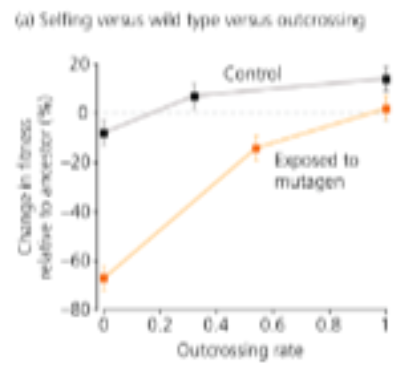
In the experiment represented by the graph, the control line (not exposed to a mutagen) shows relatively little change in fitness when outcrossing rates increase, but the line exposed to a mutagen gain significant fitness when outcrossing rates increase - why?
A. Asexual reproduction allows for greater accumulation of deleterious mutations in a population, and this cost of asexual reproduction increases when mutation rates increase
B. Asexual reproduction does not allow for novel allele combinations to fight pathogens, and the threat of pathogens is higher when mutation rates are higher
C. Sexual reproducers are always more fit than asexual reproducers, even when mutation rates are low
D. A&B
E. None of these
A
High pathogen prevalence can favor the evolution of sexual reproduction because:
A. Sexual reproduction allows adaptive gene complexes to remain together
B. Mutations are on average going to be beneficial in sexual populations
C. Pathogens are less able to adapt to their host when the host population has high diversity in alleles related to fighting pathogens
D. A&B
E. All of the above
C
Asexual reproduction can have higher fitness in stable environments because:
A. Mutation rates are lower when the environment is stable
B. Pathogens don’t evolve when environments are stable
C. Adaptive gene complexes can be maintained with asexual reproduction
D. All of these
E. None of these
C
What are the macroevolutionary consequences and patterns related to the evolution of asexual and sexual reproduction?
A. It is easier to identify species in asexuals because there is direct inheritance of genetic material from one generation to the next
B. Sexual reproduction has evolved numerous times, but often reverts to asexual reproduction
C. Asexual populations tend to be more competitive in the evolutionary short-term because they can reproduce more quickly
D. A&B
E. A&C
c
Muller’s ratchet occurs when mutations accumulate with which of the following consequences:
A. Reduced mean fitness in sexual populations after many generations
B. Increased mean fitness in sexual populations after many generations
C. Reduced mean fitness in asexual populations after many generations
D. Increased mean fitness in asexual populations after many generations
E. None of the above describe consequences of Muller’s rachet
C
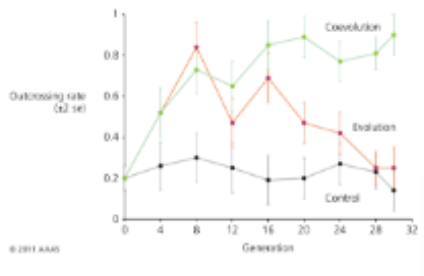
This graph shows outcrossing rates in a roundworm under different laboratory conditions: Control (constant and favorable environment, no pathogens), Evolution (initial change in the abiotic
environment, followed by a constant environment, no pathogens), and Coevolution (pathogen present). Which concepts are demonstrated in this graph?
A. Sexual reproduction facilitates adaptation to changes in
environmental conditions
B. Asexual reproduction is favored when the environment is stable
and pathogens are absent
C. Sexual reproduction allows organisms to constantly evolve in
response to pathogens
D. A&C
E. All of these
E
Which of the following are likely outcomes of high pathogen prevalence?
A. Populations with high rates of cloning are likely to suffer higher rates of infection
B. Populations with high rates of infection are likely to evolve higher rates of sexual reproduction
C. Muller’s rachet has a larger impact on fitness
D. A&B
E. All of the above
D
Which of these factors selects for small gametes?
A. More gametes can be produced as gamete size decreases
B. Zygote viability decreases as gamete size decreases
C. Motility of gametes increases as size decreases
D. A & B
E. A & C
E
Which of the following evolved before the evolution of sexual reproduction with distinct gamete types?
A. Sexual reproduction involving gametes with different mating types
B. The evolution of self-fertilization in hermaphrodites
C. The evolution of males and females
D. All of these
E. None of these
A
Sex-allocation theory predicts:
A. The ratio of male to female offspring depends on the costs and benefits of producing each sex
B. Selection favors environmental sex-determination mechanisms when it is adaptive for sex ratios to deviate from 50:50
C. In species with two sexes, total investment in male and female offspring is equal and sex ratios should be 50:50
D. A&B
E. All of these
E
When Bluehead wrasse Terminal Phase (TP) males die, what does sex allocation theory predict will
occur (assuming males are more successful than females when they are relatively large)?
A. Small females will quickly increase in size in order to be male, which maintains the sex ratio
B. The smallest terminal phase males will become females to maintain a constant sex ratio
C. When the females reach a certain age, they turn into terminal phase male
D. A and C
E. None of these
E
Which of the following is true about the evolution of sex determination mechanisms?
A. Most animals use the same sex determination system, even though plants and other kingdoms have many types of sex determination systems
B. When sex is determined primarily by genes, gene expression does not have to differ between males and females
C. When sex is determined primarily by the environment, gene expression differs between males and females
D. A&C
E. All of the above
C
Which of the following is true about the evolution of sex determination mechanisms?
A. When environmental change results in a non-adaptive shift in sex ratio, selection can favor the evolution of a new sex determination mechanism
B. Sex determination requires differences in gene expression due to different genetics in males and females
C. Sex determination mechanisms are very evolutionarily labile
D. A&C
E. B&C
E
Some species change sex over their lifetime because:
A. The benefits of being one sex are determined by phenotypes of individuals versus their competitors
B. Sex chromosomes can change over an individual’s lifetime
C. Both of these
E. Neither
A
What favors the evolution of larger gametes?
A. larger size increases mobility
B. Zygote viability increases with larger gamete size
C. Both
D. Neither
B
Which of the following are benefits of females mating multiply?
A. Females can conceal the true male parent of her offspring
B. Females ensure they receive enough sperm to fertilize all their eggs
C. Females can receive additional nutritional benefits from mating multiply
D. A&B
E. All of the above
E
One experiment showed that when females mate with the same male multiple times, they do not gain additional reproductive success, but when they mate with multiple males, they do. Why is this?
A. Females mate multiply to ensure they get enough sperm to fertilize all their eggs
B. Females mate multiply to increase the likelihood they mate with a genetically compatible male
C. Females mate multiply to increase the number of nuptial gifts they receive.
D. B&C
E. All of the above
B
What do all sex determination mechanisms all have in common?
A. Males and females have at least one gene that differs even if they don’t have distinct sex chromosomes
B. Gene expression differs between males and females
C. Both of the above
D. Neither are found in all sex determination mechanisms
B
Which of the following are true about monogamy?
A. Species that are socially monogamous can mate promiscuously
B. Monogamy is likely to evolve when a male’s territory overlaps multiple female territories
C. Monogamy can be favored when biparental care greatly increases offspring success
D. A&B
E. A&C
E
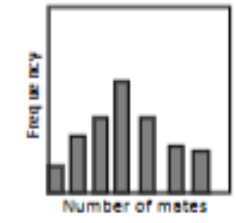
If the graph to the right illustrates female mating success, which
conclusions can you make?
A. Males must be the more competitive sex
B. It is difficult for a single male to dominate matings
C. Resources are likely to be clumped
D. All of the above
E. None of the above
E
26. Which of the following would likely favor a mating system that favors large male weaponry?
A. Females gain social information from associating with each other
B. Resources are evenly distributed and male territories are equal
C. Males defend territories with unevenly distributed resources
D. A & B
E. A & C
E
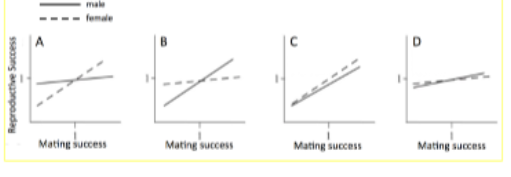
Which of the following describes how the timing of female maturation affects the degree of male reproductive skew when males compete strongly for mates?
A. Males are likely to show high reproductive skew when females mature at the same time
B. Males are likely to show high reproductive skew when females mature at different times
C. Males are likely to show low reproductive skew when females mature at different times
D. A&C
E. B&C
B
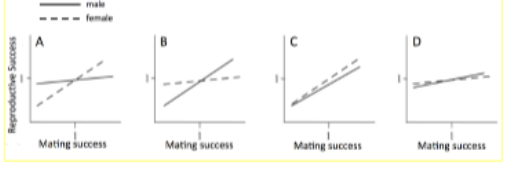
Which of the following are likely to be true?
A. In A, females are unlikely to increase reproductive success by mating with more than one male
B. B shows expectations for Bateman’s gradients for a sex-role reversed species
C. C is a population in which females compete much more strongly for mates than do males
D. A&B
E. None of these
E
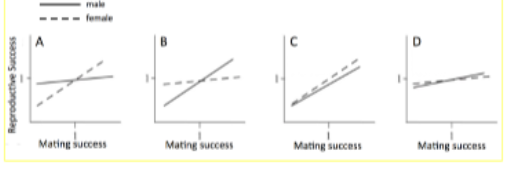
What predictions can you make based on data represented by these graphs?
A. Which sex is likely to compete strongly for access to mates
B. Which sex is likely to have higher variation in mating success among individuals
C. Which type of polygamy is likely to occur in the population
D. A&B
E. All of the above
D
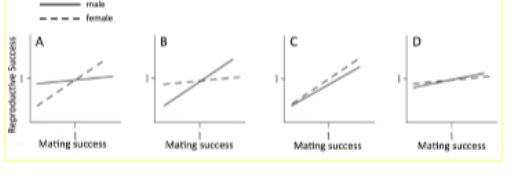
In which population(s) do you predict that males and females compete similarly as one another?
A. A
B. C
C. D
D. A&C
E. C&D
E
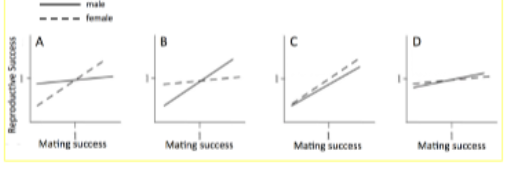
In graph D, for which sex will the quality of their partner be more important than the number of
mates for maximizing reproductive success?
A. Males
B. Females
C. Males and females
D. Cannot make an informed prediction based on the graph
C
Which of the following are likely to contribute to the Operational Sex Ratio (OSR)?
A. The male:female sex ratio at birth
B. Survival of males versus females during the mating season
C. Differences in the timing of maturation between males and females
D. All of these
E. None of these
D
What are the likely consequences of a 50:50 sex ratio changing to a 70:30 male:female sex ratio?
A. It should increase competition for mates among females
B. It should increase mating skew among females
C. It should decrease mating skew among males
D. It should increase competition for mates among males
E. A&B
D
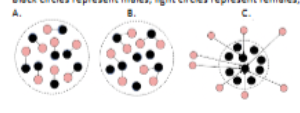
Which of the above mating system(s) should favor male ornamentation but not male weaponry?
A. A
B. B
C. C (this is a lek, where males do not fight, they simply display)
D. B&C
E. None of the above
C
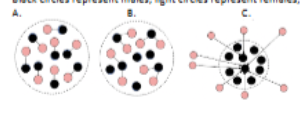
Which of the above mating system(s) are least likely to favor elaborate ornamentation or weapons in
males?
A. A
B. B
C. C
D. A&B
E. B&C
A
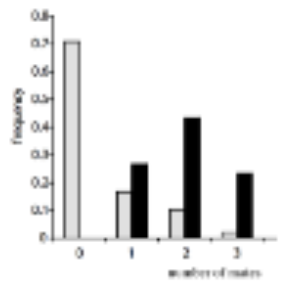
The graph to the right represents a population that is sex role reversed. Which color bars correspond to females and why?
A. Gray because reproductive success is fairly evenly distributed
B. Gray because reproductive success is highly skewed
species, females are more competitive, and so skew is higher.
C. Black because reproductive success is fairly evenly distributed
D. Black because reproductive success is highly skewed
B
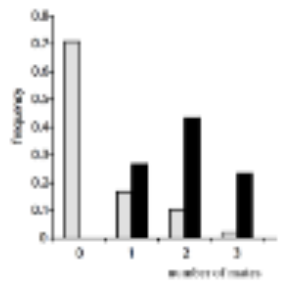
Use the graph from Q36. If males are represented by gray bars, which of the following mating
systems could generate this pattern in males?
A. Sex role reversal with females competing to lay eggs in male nests
B. Male territory defense with a highly uneven distribution of resources
C. Male territory defense with an even distribution of resources
D. A&B
E. B&C
B
What factors determine the sex that is choosier in selecting mates?
A. Gamete size
B. Relative body sizes of the sexes
C. Nutritional investment of each sex in the offspring
D. A&C
E. All of the above
D
Why might a mating system vary across populations?
A. How clumped versus dispersed resources are varies across populations
B. The importance of biparental care varies across populations
C. The size of males relative to females varies across populations
D. A&B
E. All of the above
D
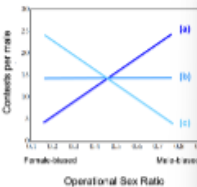
Using the graph to the right, which are the most likely
consequences of variation in operational sex ratio (OSR)?
A. Line A: when OSR is male-biased, males compete more
strongly and average male mating success is lower
B. Line A: when OSR is male-biased, males compete more
strongly and average male mating success is higher
C. Line C: when OSR is male-biased, males compete less
strongly and average male mating success should be lower
D. Line C: when OSR is male-biased, males compete less
strongly and average male mating success should be higher
A

The graph shows average fitness (i.e. reproductive success) of two
alternative male strategies. For A, males display to attract the attention of females. For B, males sneak copulations without displaying. Which of the
following are likely true in this species?
A. The strategies are genetically determined
B. The strategies are developmentally determined
C. Selection will lead to the fixation of strategy A
D. Selection will lead to the fixation of strategy B
E. B&D
B if conditional but E is acceptable
Which is/are true about both genetic and conditional alternative male mating tactics?
A. The alternative male strategies must have similar average reproductive success for both to be maintained in the population this is not true for conditional strategies, which actually are
based on one being worse than the other
B. The environment
C. The developmental environment (e.g., food availability) can alter the proportion of each male mating strategy in the population this is only expected for conditional
D. A&B
E. All of the above
B
Which of the following are secondary sexual traits?
A. The presence of testes vs ovaries
B. The shape of the scoops on the genitalia of dragonflies used to scoop out competitor’s sperm while part of the genitalia
C. Hormone profiles of males and females
D. A&B
E. None of these
B
Intrasexual competition shapes which of the following phenotypic traits?
A. Larger body sizes in males or females
B. Evolution of more competitive sperm
C. Larger body sizes in males only females can also be favored to have large bodie
D. A&B
E. All of these
D
Which of the following statements are true about sexual selection
A. It favors male-female competition
B. It favors aggression in males only
C. It favors attractiveness in males only
D. It favors aggression and attractiveness in either sex
E. B&C
D
Which of the following are true about when sperm competition is favored and the specific traits favored by sperm competition?
A. Polygamy favors the evolution of larger ejaculates
B. Monogamy favors the evolution of greater sperm production if monogamy is in place, then sperm competition does not occur
C. Polygamy favors male traits that eject sperm of prior competitors or block the sperm of future competitors
D. A&C
E. All of these
D
When should males compete strongly enough to risk injury?
A. When the risk of injury is greater than the benefits gained from winning a competition
B. When the risk of injury is high, but the costs of losing and benefits of winning are also high
C. When the fights occur over resources with low value
D. A&B
E. All of these
B
Which of the following describes male-male intrasexual selection?
A. The sperm of some males is favored by female reproductive tracts
B. The sperm of some males are faster at reaching and fertilizing female eggs
C. Some males are visually more attractive to potential mates than others this is intersexual selection
D. A&C
E. None of these
B
Which of the following describe female aggression shaped by sexual selection?
A. Fighting to gain access to resources that allow them to produce secondary sexual traits that are attractive to males
B. Fighting over resources to increase their egg production fecundity selection is natural selection
C. Fighting over resources to provision their young this is natural selection
D. B&C
E. All of these
A
Which of the following should favor intrasexual selection in females?
A. Limited access to mates that vary in quality
B. High value of nuptial gifts and limited resources in the environment
C. Increased success of males that are highly aggressive this would be correlational selection, which is not adaptive for females
D. A&B
E. All of these
D
Sexual selection on males typically results in which of the following?
A. Secondary sexual traits that increase survival
B. Complex female reproductive tracts
C. Infinite elaboration of male ornaments
D. B&C
E. None of these
E
Which of the following statements are correct?
A. Males with the best direct benefits always have the best indirect benefits
B. Indirect benefits allow females to gain resources through mating
C. Direct benefits include good genes for the offspring
D. B&C
E. None of these
E
When females gain benefits from mating, which of the following are likely outcomes of forcing a female to mate with an unpreferred male?
A. Females may invest more in their offspring to compensate for poorer genetics.
B. The quality of her offspring or direct benefits will be on average lower than if she was allowed to mate with her preferred male
C. Females may be more likely to re-mate with another male, given the opportunity
D. All of the above
E. Indirect benefits models predict none of these outcomes
D
Male katydids provide females with a large and nutritious gift. Which of the following are necessary for female preferences to evolve under a direct benefits model?
A. Fitness of the male is heritable
B. Offspring of females mating with males with the largest gift have higher genetic quality
C. Both of these
D. Neither of these
D
What must be true for a female mate preference for larger red color patches on male guppies to evolve under an indirect benefits model?
A. The size of the male’s red patch is positively correlated with offspring fitness
B. The size of the red patch is passed onto offspring
C. The size of the male’s red patch is positively correlated with mate preferences of his sisters and daughters.
D. A&B
E. All of the above
A

Which of the following graphs depict a requirement of the evolution of female mate preferences for orange patches under a sensory exploitation model?
A. A
B. B
C. C
D. B&C
E. None this is a non-adaptive model.
E
Which of the following include direct benefits females can receive from their mates?
A. Increased chemical protection to the female
B. Parental care of the female’s offspring
C. Sperm with high quality genetic material (this is an indirect benefit)
D. A&B
E. All of the above
D
Females choose mates with the biggest orange spots, but receive the same fitness benefits regardless of the size of her mate’s orange spot. Which model(s) of the evolution of female preferences are consistent with this pattern?
A. Indirect benefits
B. Sensory exploitation
C. Fisherian selection
D. B&C
E. All of the above
D
Which of the following findings would be sufficient to support that a sword has evolved via sensory exploitation in a fish species?
A. Females in a single species without a sword prefer males with artificial swords
B. Species closely related to a sword-tailed species also show swords
D. A&C
E. None of the above
E
Which is/are true about indirect versus direct benefits models for the evolution of female preference?
A. For both models, male sexual traits must be heritable, and tied to offspring fitness
B. For both models, male fitness must be heritable, and the trait must reflect condition
C. For both models the male trait must, on average, correlate with the benefit(s) the female receives from mating with a given male
D. A&B
E. All of the above
C
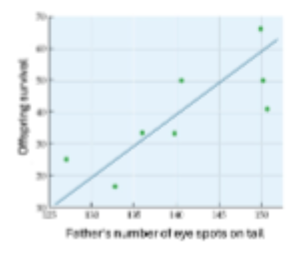
Given the data in the graph here, what is the most
likely model of evolution for the preference for eyespots
in this species?
A. Males provide direct benefits to females that allow
female to produce more offspring.
B. Females benefit from receiving good genes from
males with more eye spots
C. Fisherian, because female offspring have stronger
preferences for eye spots
D. All of the above
E. None of the above
B
Which of the following patterns would support the hypothesis that female mate preferences are adaptive/beneficial?
A. Females that have weaker preferences have greater numbers of offspring
B. A given female’s reproductive success is greatest when she has to compete for territory
C. Females that mate under conditions that allow for them to fully express their preference are reproductively more successful
D. A&C
E. All of the above
C
What processes are involved, or affected, when females remate quickly after mating with a
non-preferred male?
A. Cryptic choice
B. Sperm competition
C. Good genes
D. A&B
E. All of these
D
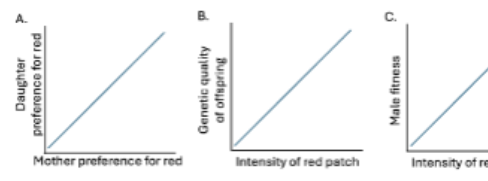
Which of the following graphs illustrate requirements for female mate preferences to evolve via Fisherian selection?
A. A
B. B
C. C
D. A&C
E. B&C
A
For genic capture, which processes ensure that only the most fit individuals can produce the most elaborate ornaments?
A. Low mutational load is necessary to have high performance in multiple types of behavioral and physiological functions
B. Only males with very efficient metabolism, cell functioning, foraging, etc. will be able to invest in the most elaborate ornaments.
C. Ornaments are condition-dependent and tradeoff with other traits, like immune function.
D. A&B
E. All of the above
D
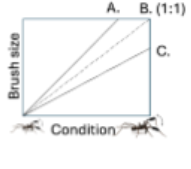
Which of the following statements are likely to be true about lines A, B (1:1), and C in the graph below.
A. Line A is a good indicator of good genes, and female preference for this trait should be favored
B. Line B is a good indicator of good genes, and female
preference for this trait should be favored
C. Line C is a good indicator of good genes, and a female preference for this trait should be favored
D. A&B are both good statements
E. All are good statements
A
Which of the following are true about the strength of preferences?
A. Males with low potential reproductive rates often show stronger mate preferences if he can’t mate often, he will be picky about which females he mates with when he does
B. Females with low reproductive potential often show stronger mate preferences the opposite
C. Males with high potential reproductive rates often show stronger mate preferences
D. A&B
E. B&C
A
The lock and key hypothesis of genitalia evolution predicts which of the following?
A. Male genitalia of closely related species are likely to be more different from each other than are the female genitalia in the same species
B. Male and female genitalia coevolve together primarily in shape
C. It is difficult for genitalia from different species to pair together
E. B&C
F. All of the above
E
Which of the following are true about the evolution of genitalia?
A. The lock and key hypothesis predicts parallel evolution in primarily the shape of male and female genitalia
B. Genitalia evolve differences across populations very quickly
C. Pleiotropy should generate similar changes in male and female genitalia size but not shape
D. A&B
E. All of the above
D
Why is it important to study both male and female genitalia when testing hypotheses about the evolution of genitalia?
A. Considering the shape of both male and female genitalia can help reveal how the genitalia articulate together, and thus the likely mechanism shaping their evolution
B. It isn’t important. Male genitalia are often sufficient to understand sperm competition and cryptic choice
C. While changes in male genitalia are the most important primary drivers of genitalia evolution, looking at female genitalia provides clues as to the function of the male genitalia
D. A&B
E. All of the above
A
Females may exhibit weak mate preferences when resources are limited because:
A. Their ability to determine the highest quality males is diminished
B. She may be nearing the end of her life and so it does not benefit to be choosy
C. Their potential reproductive rate is low
D. A&B
E. All of the above
B
When should males exhibit strong mate choice?
A. When he is able to remate quickly
B. When females are generally high quality
C. When operational sex ratios are male-biased
D. When many females are available to mate
E. A&C
D
Which are costs of mating for males?
A. Energetic investment in courtship
B. Increased conspicuousness to predators, even when it attracts females
C. Attempting to mate with, or actually mating with, the wrong species
D. A&B
E. All of the above
D
When is it be beneficial for males to engage in same sex sexual behavior at least some of the time?
A. When males can indirectly inseminate females by depositing sperm packets onto other males
B. When discriminating between the sexes is very costly
C. When there are far more males than females in the population
D. A&B
E. All of the above (did not grade this one)
D
How might the social environment influence patterns of mating?
A. When other species are around, some individuals could mismate with the wrong species
B. Males may reduce the number of mates they copulate with because they spend longer guarding a
mate after copulation
C. Females may be more likely to mate with individuals with familiar phenotypes.
D. A&B
E. All of the above
E
Which of the following are true about the effects of the social environment on mate preferences and mate choice?
A. Females that copy the mate choice of other females are likely, on average, to mate with higher quality males than if they mated at random
B. Females can reduce the costs of mate searching by copying the choice of other females
C. Females can reduce how choosy they are about mates if high-quality mates are scarce in the environment
D. B&C
E. All of the above – I took D too
E
Which is/are true about female mate preferences?
A. Female mate choice is unlikely to change across different environments, but preferences often do
B. Females within a population are fairly uniform in their mate preferences
C. The benefits of mating with preferred male does not change across environments, but costs do
D. B&C
E. None of the above
E
Why is it more likely that indiscriminate mating is ancestral, and different sex sexual behavior is the derived form of sexual behavior?
A. It is evolutionarily unlikely that sexual reproduction and different sex sexual behavior would evolve nearly simultaneously.
B. Same sex sexual behavior, or low discrimination, is highly prevalent across the animal kingdom.
C. The sensory systems necessary to discriminate between the sexes are costly and unlikely to evolve shortly after the evolution of sexual reproduction
D. All of the above
E. None of the above
D
Same sex sexual behavior (or indiscriminate mating) may evolve because:
A. It is costly to produce the sensory systems necessary to accurately identify males versus females.
B. Courtship practice with other males can improve mating success with females
C. Aggression in a population can lead to hormones that stimulate sexual behavior
D. A&B
E. All of the above
D
What are some potential resolutions (explanations) to the lek paradox?
A. In different environments, different male genotypes are the most fit
B. Female preferences are not always expressed strongly or consistently across environments or conditions
C. Sensory exploitation introduces more variation than can be eroded by female preferences
D. A&B
F. All of the above
D
If there is intralocus sexual conflict in a population, what are some evolutionary outcomes that resolve conflict either partially or wholly?
A. Males and females express the same trait value
B. Size evolves to an intermediate size such that neither males nor females are at their fitness optima for size
C. Size is regulated to be sex-specific so that each sex expresses a trait value closer to their optimum
D. A&B
E. All of these resolve conflict partially or wholly
C
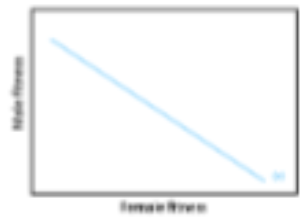
The graph to the right illustrates male and female fitness. Which phenomena could this represent?
A. Intralocus sexual conflict, where males with a specific trait value negatively impact the females with which they interact
B. Interlocus sexual conflict, where males with a specific trait value negatively impact the females with which they interact
C. Intralocus sexual conflict, where an allele with a positive impact on fitness in males has a negative impact on fitness in their sisters
D. A&C
E. B&C
E
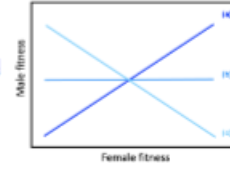
Which relationship of fitness for male and female siblings illustrated in the graph to the right is expected under unresolved intralocus
sexual conflict?
A. A
B. B
C. C
D. B&C
E. Cannot tell from graph
C
Which statement(s) is/are true about intralocus conflict?
A. Intralocus conflict is when a male expresses a trait that is detrimental to females with which he interacts in a reproductive context
B. Intralocus conflict arises due to shared genomes between related
males and females
C. Intralocus conflict arises due to sex-specific expression of traits
D. A&B
E. B&C
B
How might interlocus sexual conflict decrease female fitness?
A. Males may kill a female’s offspring so she is able to mate sooner
B. Males can transfer compounds with their sperm that reduce female lifespan and reproductive output
C. Males provide nuptial gifts to help his offspring develop
D. A&B
E. All of the above
D
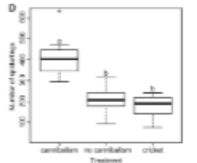
This graph shows offspring number in a spider species where males typically mate once. After mating, males are: cannibalized (left), not cannibalized (middle), and not cannibalized but females ate a cricket instead (right). Why is this sexual
conflict (or not)?
A. Conflict because males lose reproductive output by being cannibalized, and females gain fitness.
B. No conflict because both males and females increase fitness with cannibalism.
C. Conflict because males are losing future
reproductive opportunities by investing in the current one
D. A&C
E. None of these
B
Which of the following are true about interlocus sexual conflict?
A. It evolves quickly as adaptations and counteradaptations evolve
B. It can favor male manipulation over female mating, and female
countermeasures to resist manipulation
C. It can be resolved by sex-specific trait expression
D. A&B
E. All of these
D
Which criteria can be used to consistently/always identify a selfish genetic element:
A. Transmission of >50% at meiosis and beyond
B. Increased copy numbers in a genome over generations
C. An negative effect on external phenotype
D. A&C
E. All of the above
A
The identification of selfish genetic elements (SGEs) have made scientists realize which of the following?
A. All aspects of the genome should integrate to promote fitness of the organism
B. Some genetic regions can increase their own fitness at the cost of other regions of the genome or even the host organism
C. Meiosis does not always result in 50:50 transmission of alleles
D. A&B
E. B&C
E
The genome evolves counter measures to selfish genetic elements because
A. They are almost always linked to mutations that cause disease
B. Most feminize the host, and mutations favoring the production of male gametes will be strongly favored by selection
C. They have an overall negative effect on the organism
D. A&C
E. None of the above
C
Killer Y sperm will kill most sperm containing a Y chromosome, which leads to reduced male fertility. How do females make up for the loss of fertility?
A. Females mate promiscuously
B. Females with the Killer Y allele have increased fecundity
C. Neither of these
D. Both of these
A
Which are true about selfish mitochondria?
A. Mutations in the nuclear genome countering selfish mitochondria are favored by selection
B. Mitochondrial genome mutations increasing resource allocation to females reproductive parts are favored by selection.
C. They typically decrease pollen output in plants
D. A&B
E. All of these
E
Gene converters and transposons both insert additional copies of themselves in the genome. How do they differ in costs to the “host”?A. Biased gene converters lead to increased homozygosity at the site of the gene converter and so can appear to be adaptive
B. Transposons show greater than 50% transmission at meiosis and beyond
C. Biased gene converters are more likely to end up in the functional gametes at gametogenesis (this related to meiotic drivers)
D. A&B
E. None of the above
D
Why are selfish genetic elements observed more often in hybrids between strains or species?
A. Selfish genetic elements can become rapidly fixed in a population, which makes it hard to identify them
B. Suppressors evolve quickly to fixation and counter the selfish genetic elements within a population
C. Hybrids can inherit a suppressor for the wrong selfish genetic element, and therefore the effects of the SGEs become apparent.
D. All of these
E. None of these
D
How does Wolbachia help reduce the spread of Dengue by mosquitos?
A. It can reduce overall fecundity or offspring survival
B. Offspring between two individuals with Wolbachia are always
C. It can increase pathogen replication so Dengue kills the mosquito before spreading
D. A&B
E. A&C
A
Which are meiotic drivers?
A. Both true and meiotic drivers increase their own likelihood of transmitting to the next generation.
B. Both true meiotic drivers and gamete killers reduce the number of viable gametes
C. Gamete killers are more likely in males because gametes are less costly to produce in males.
D. A&B
E. A&C
E
What are some of the major consequences of selfish genetic elements?
A. Rapid evolution between selfish genetic elements and other regions of the genome that suppress positive effects of selfish genetic elements
B. The evolution of novel sex determination mechanisms
C. Reduction in male fertility due to increased investment in female reproductive tissues
D. B&C
E. All of the above
D
Which is/are correct statements about imprinting?
A. Paternally imprinted loci are expressed only in male offspring.
B. Imprinting is necessary for normal fetal development in many mammals
C. Methylation patterns are passed down several generations
D. A&B
E. All of these
B
Genomic imprinting is a mechanism by which:
A. All aspects of growth and development are regulated by either entirely the paternal or entirely the maternal genome.
B. DNA editing occurs to regulate which alleles are actively expressed
C. Environmental stressors affect the expression of offspring phenotype
D. A&B
E. None of the above
E
Which represents evidence that intersexual conflict in mammals has contributed to the evolution of genomic imprinting patterns?
A. Imprinting occurs primarily in genes involved in early growth and
development of the fetus, for which males and females have different optima
B. Paternally and maternally imprinted genes are often related to the same developmental pathways but have counteractive effects
C. Removing patterns of imprinting allows for the development of larger, healthier offspring
D. A&B
E. None of the above
D